13 Proven Workouts for Building a Powerful Chest

A strong chest isn't just for showing off at the beach. "Building powerful chest muscles will improve your ability to push things, such as a grocery cart, a stroller, a car that stalled, putting your child in their crib, or even moving a sofa from one side of the room to the other," says Jennifer Rulon. A 15-time Ironman triathlete, Rulon says she "lives the life of a healthy human who loves to coach others to become the best versions of themselves."
"Another essential reason to have a powerful chest," she goes on, "is that it can genuinely improve posture. Why? While the chest muscles support many muscles, the shoulders play a huge role in keeping the body upright. Many people have switched to standing desks to improve posture instead of being concave at their desks with rolled shoulders and collapsed chests. Speaking of which," she goes on, "having a solid chest can also improve breathing."
"The chest is a very important part of the body to continue conditioning through movement, strength training, and stretching," adds long-time yogini and fitness expert Alex Sabbag. "Located inside the chest is our most vital organ, the heart. The heart is often overlooked when we talk about the chest, but given how much the heart does for us throughout our lives, it's an important part of the body to take a look at."
Here are proven workouts for building a powerful chest.
Bench Press
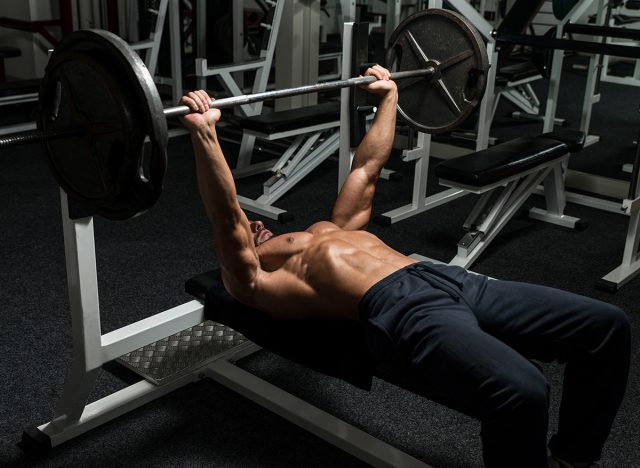
"A bench press is one of the best exercises for building the chest. The bench press will utilize the pectoral muscles (chest), triceps, and delts (shoulders). You can do bench press with dumbbells or a barbell. If you are at home and don't have either, you can utilize canned goods or 1 lb water bottles," says Rulon. Why Bench Press? "It is a compound movement that engages your chest, shoulders, and triceps, activating joints such as the shoulder, elbows, and wrists," she says. "Bench presses – incline, decline, and flat – play a pivotal role in building a comprehensive and powerful chest," says Jim Richard, Certified Personal Trainer, Fitness Blogger and Online Wellness Coach. "The incline bench press specifically targets the upper chest fibers for well-rounded chest development. The decline bench press works the entire chest more effectively, allowing you to lift heavier weights, which is key for muscle growth. Hot Tip: "If you don't have a bench, you can head to the floor for a press. While you are limited in the range of motion for a floor press, you are still working the chest," she says. "Regularly incorporating these exercises into your fitness routine, with a focus on proper form and adequate recovery, will lead to huge improvements in chest strength and muscle," adds Richard.
Related: #1 Weight Loss Food Mistakes You Are Making
Push Ups
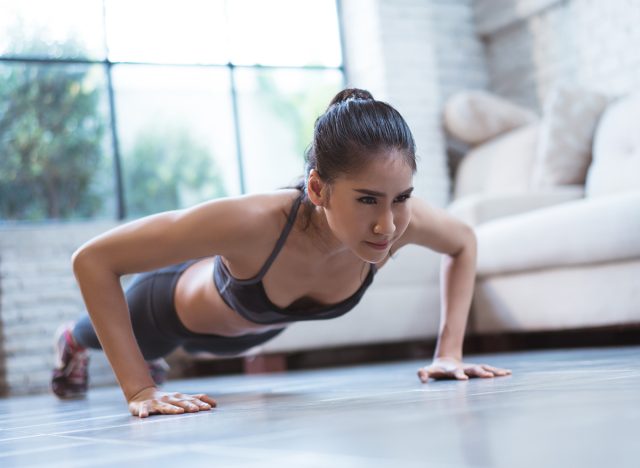
"Push-ups are also a fantastic exercise for the pectoral muscles and the shoulders, biceps, triceps, abs, and upper back," says Rulon. Why Push Ups? "Once again, so many muscles are being used along with the joints. With push-ups, you fully extend the core within a plank before you lower it to the ground. Remember that push-ups can be done anywhere: at home, at an office on your break, on a beach, or at a gym," she says. Hot Tip: "Some people struggle with push-ups, and many alternatives exist. You do a push-up on a wall, but if that is too easy, you can head to a bench. And build your push-ups that way. You can alternate from the floor to the bench. Can you lead to your knees for a push-up? You can, but it is a hard habit to break," she says.
Dumbell Chest Fly
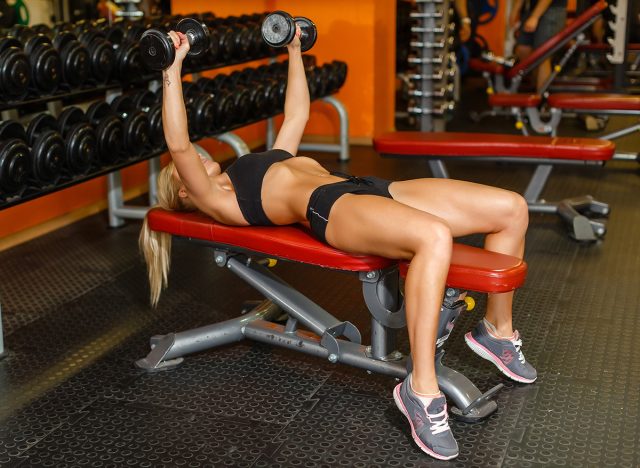
"Dumbbell Chest Fly will utilize the pectoral muscles, delts, biceps, and triceps just like others, but the flies can help with flexibility and coordination," says Rulon. Why Dumbbell Chest Fly? "Like the bench press and the push-ups, many muscles are utilized to build muscles during this exercise. With DB Chest Fly, this exercise will help lengthen the upper back and the shoulders for more flexibility." Hot Tip: "If you are a beginner, start with a light set of dumbbells, and increase the amount each week as you begin to build," she says.
Related: I Lost 40 Pounds in 4 Months With These Simple Tricks
Plyometric Banded Push-Ups
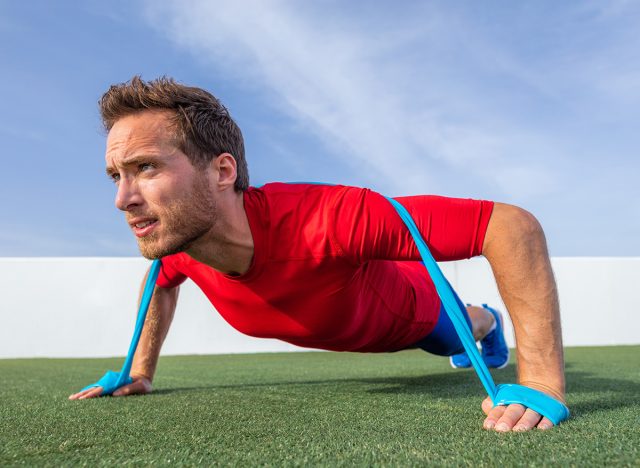
"Plyometric banded push-ups are greatly underutilized in developing a powerful chest," says Jim Richard, Certified Personal Trainer, Fitness Blogger & Online Wellness Coach at TK. Why Those? "They involve explosive movements enhanced by the resistance of bands, effectively targeting and strengthening the chest muscles. The movement activates the fast-twitch muscle fibres used in quick, powerful movements, boosting overall strength and athletic ability," he says. Hot Tip: "Adding variations like clapping push-ups or resistance bands intensify the workout, further engaging the chest, shoulders, and core muscles. This form of training builds chest muscle power," he says.
Single-Arm Dumbbell Bench Press
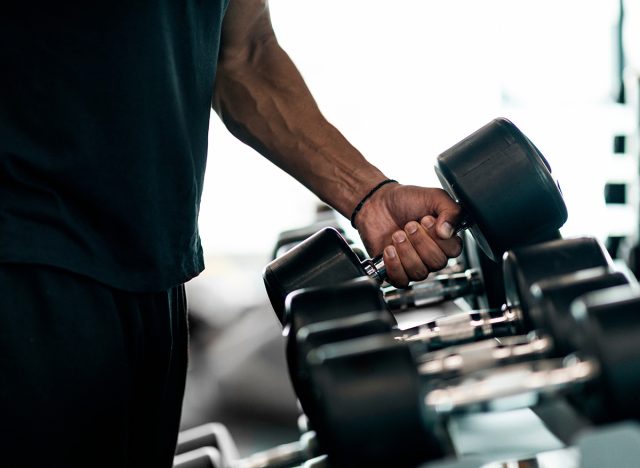
"This isolates each side of the chest, promoting balanced development and enhancing core stability," says Chris Pruitt, CEO & Certified Trainer at WorkoutHealthy.
Landmine Press
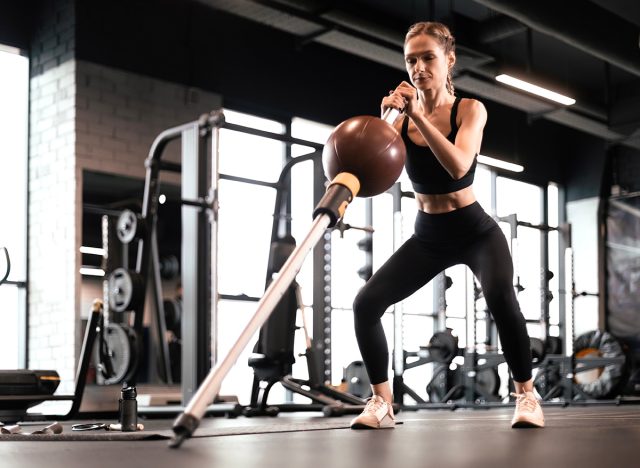
"An excellent movement for upper chest development, this is performed by pressing one end of a barbell (with a weight plate) upwards from a standing position, with the other end anchored," says Pruitt.
Related: I'm a Nutritionist and These are the Best Banana Recipes For Weight Loss
Assisted Pull-Up Machine for Lower Chest
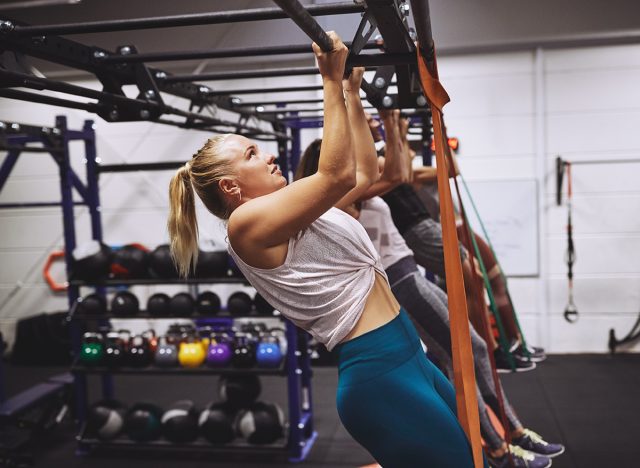
"A novel approach to work the lower chest," says Pruitt. "Stand in front of the machine, place your hands on the knee pad, and press down by extending your arms to engage the lower chest muscles. This method offers an easier setup than traditional barbell/dumbbell decline bench presses and the same effective isolation of the lower chest." He sums up his offerings: "These exercises are some unique approaches to chest development, focusing on both the upper, mid, and lower pectorals, ensuring balanced muscle growth."
"Other chest exercises can include dumbbells, barbells, bands, and suspension training. Ensure you find what is best for you and your comfort level when preparing for chest exercises," says Rulon.
And Now For Some Yoga Poses, Starting With This Warmup
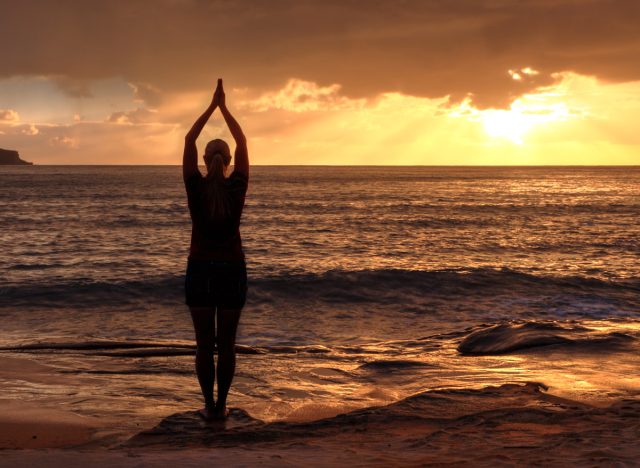
"We are approaching February, a month commonly known for the heart—studies show that people actually do suffer from a broken heart—and energetically, when we are blocked, it's likely due to our heart feeling conflicted, hurt, or out of balance," says Sabbag. "In yoga, we focus on the mind, body, and soul and place a lot of emphasis on taking care of the heart, physically and energetically. Here are some easy ways you can take care of your heart while bringing additional strength and openness to the chest chamber," says Sabbag.
"Standing forward, fold with bound arms. Standing at the top of the mat in Tadasana, or Mountain pose, clasp the palms behind the low spin. Fold forward and let the knuckles drape over the back of the skull. This will warm up the shoulder area to prepare for additional heart opening and chest expanding postures."
Open Heart Pose (commonly known as Puppy Dog pose)
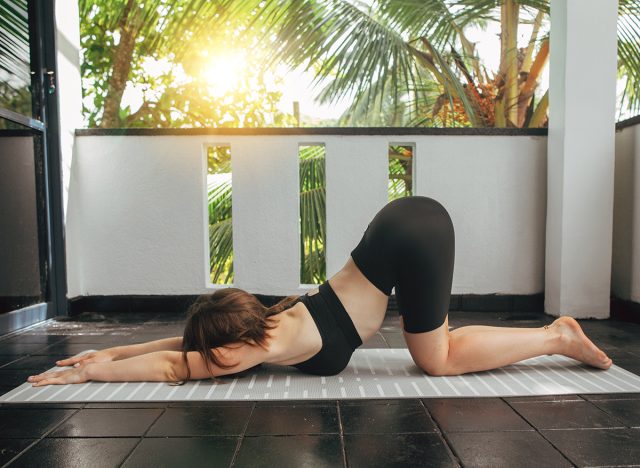
"This posture will open up the front and back side of the heart," says Sabbag. "From Tabletop position, walk the fingers forward with the arms extended out to a big y shape until the hips are lifted up over the knees. Keep surrendering the chest down toward the earth. The forehead, chin, or chest may actually reach the ground. The back of the armpits and chest will feel expansive in this posture. Hold for 2-3 minutes."
Related: Top 10 States Obsessed With Gaining Muscle—Ranked
Modified Chaturanga
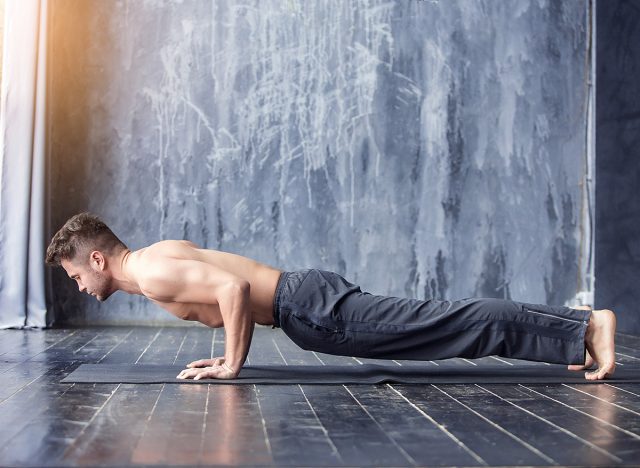
"From Tabletop, shift the shoulders forward past the wrists and lower down halfway, elbows hugging the ribcage. Then press directly back up. This builds strength in both the back of the arms (triceps) and across the chest. Do 5-10, resting in Child's Pose as needed," says Sabbag.
Iron Cross
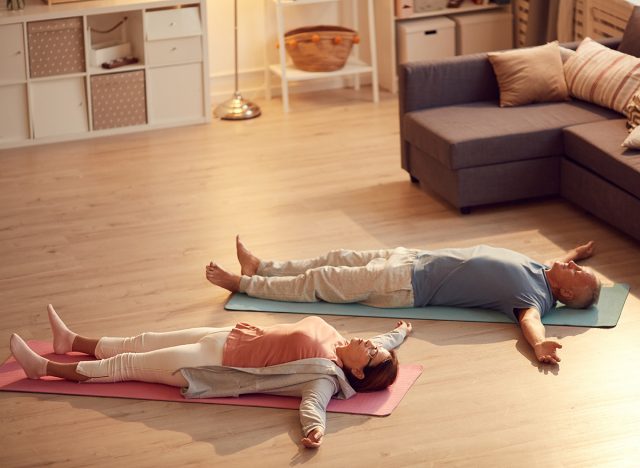
"Come all the way down to your belly," says Sabbag. "Place one hand by the rib cage and extend the other arm out to a T shape. Press down on the palm next to the ribs and roll toward the extended arm. This opens up the front side of the chest and also the heart while compressing the pack of the heart and bringing some relief to the shoulder areas. Do both sides and hold for 2-3 minutes per side."
Heart Openers
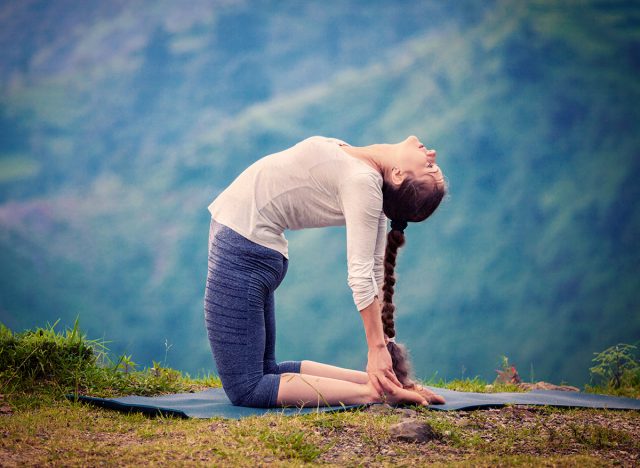
"More traditional heart openers like Bridge Pose, Wheel, Camel, or a standing balancing posture like Dancer Pose are incredible postures to keep the heart open and chest strong. Allowing the chest to relax and expand also offers relief to the top of the shoulders, a place where we carry so much tension. When the chest is tight, the shoulders are rounded and pulled down toward the chest. Keeping the chest open allows the shoulders to stay back and the shoulder blades to relax down the spine," says Sabbag.
Related: I Shed 99 Pounds Naturally With These 4 Changes
Chest Workout Mistakes to Avoid
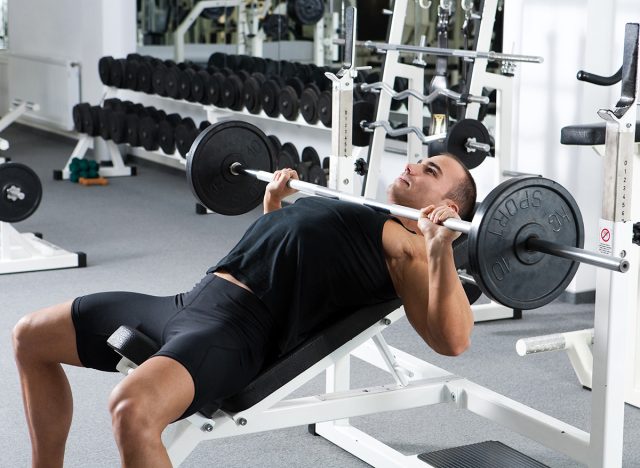
"One of the most common mistakes for all exercises at home or the gym is needing the correct form. If you have the incorrect form with a bench press, that could cause many issues, especially if you don't have a spotter and it went too heavy," says Rulon. "Another common mistake to avoid when doing a bench press is bouncing the bar off the chest. Many people will do this too quickly and use the quick momentum to bring the bar back up. If the goal is to get ten reps, but you can only do eight without bouncing, then stay with the 8 reps vs. improper form on the last two. The last common mistake for many is overtraining. Sure, we want a nice chest for the beach or a nice booty for an event, but you must remember that rest days are essential. Rest days are when the body can recover the mind, body, and soul."




